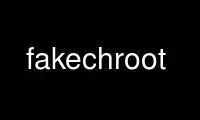
This is the command fakechroot that can be run in the OnWorks free hosting provider using one of our multiple free online workstations such as Ubuntu Online, Fedora Online, Windows online emulator or MAC OS online emulator
PROGRAM:
NAME
fakechroot - gives a fake chroot environment
SYNOPSIS
fakechroot [-s|--use-system-libs] [-l|--lib library] [-d|--elfloader ldso]
[-e|--environment type] [-c|--config-dir directory] [-b|--bindir directory] [--] [command]
fakechroot -h|--help
fakechroot -v|--version
DESCRIPTION
fakechroot runs a command in an environment where is additional possibility to use
chroot(8) command without root privileges. This is useful for allowing users to create own
chrooted environment with possibility to install another packages without need for root
privileges.
fakechroot replaces some C library functions (chroot(2), open(2), etc.) by ones that
simulate the effect of being called with root privileges.
These wrapper functions are provided as a shared library libfakechroot.so which is loaded
through the "LD_PRELOAD" mechanism of the dynamic loader. (See ld.so(8))
In fake chroot you can install i.e. Debian bootstrap with debootstrap(8) command. In such
environment you can run i.e. apt-get(8) command to install another packages. You don't
need a special privileges and you can run it on common user's account.
OPTIONS
-l library|--lib library
Specify an alternative wrapper library. The default is libfakechroot.so
-d ldso|--elfloader ldso
Specify an alternative dynamic linker. This dynamic linker will be invoked directly.
-s|--use-system-libs
Use system libraries before chroot's libraries. This might be a workaround if system
dynamic linker can not load libc.so from fake chroot.
Try this setting if you noticed following errors:
$ fakechroot /usr/sbin/chroot /tmp/sarge /bin/true
/bin/true: relocation error: /srv/sarge/lib/tls/libc.so.6: symbol _dl
_starting_up, version GLIBC_PRIVATE not defined in file ld-linux.so.2
with link time reference
$ fakechroot /usr/sbin/chroot /tmp/centos4 /bin/true
Segmentation fault
-e|--environment type
Load additional configuration with environment. This configuration file is a shell
script which is executed before calling command. The script can set additional
environment variables, like i.e.: "FAKECHROOT_EXCLUDE_PATH", "FAKECHROOT_CMD_SUBST" or
"LD_LIBRARY_PATH".
The environment type is guessed based on command name with optional extension removed
(e.g. running gettext.sh loads "gettext" environment file). If command argument is
fakeroot(1) this argument is omitted and next argument is taken as environment type.
The configuration file name is type.env and is searched at $HOME/.fakechroot and
/etc/fakechroot directories.
The default environment type is default and its configuration file name is
"default.env".
The special environment none means that no environment settings are loaded at all.
-c|--config-dir directory
Specify a directory which contains additional configuration for fakechroot. The
default directory are "$HOME/.fakechroot" and "/etc/fakechroot".
-b|--bindir directory
Specify a directory which contains the replacement executables shipped with
fakechroot. Those are script files with the extension ".fakechroot". By default they
are distributed over the "bin" and "sbin" directories in fakechroot's install prefix,
but sometimes a fixed location at build time is not feasible.
[--] command
Any command you want to be ran as fakechroot. Use '--' if in the command you have
other options that may confuse fakechroot's option parsing.
-h Display help.
-v Display version.
EXAMPLES
An example session with fakechroot:
$ id
uid=1000(dexter) gid=1000(dexter) groups=1000(dexter)
$ fakechroot fakeroot debootstrap sid /tmp/sid
I: Retrieving Release
I: Retrieving Release.gpg
I: Checking Release signature
...
I: Base system installed successfully.
$ fakechroot fakeroot chroot /tmp/sid apt-get install -q hello
Reading package lists...
Building dependency tree...
Reading state information...
The following NEW packages will be installed:
hello
0 upgraded, 1 newly installed, 0 to remove and 0 not upgraded.
Need to get 57.4 kB of archives.
After this operation, 558 kB of additional disk space will be used.
Get:1 http://ftp.us.debian.org/debian/ sid/main hello amd64 2.8-4 [57.4 kB]
Fetched 57.4 kB in 0s (127 kB/s)
Selecting previously unselected package hello.
(Reading database ... 24594 files and directories currently installed.)
Unpacking hello (from .../archives/hello_2.8-4_amd64.deb) ...
Processing triggers for man-db ...
Processing triggers for install-info ...
Setting up hello (2.8-4) ...
$ fakechroot chroot /tmp/sid hello
Hello, world!
FAKEROOT
fakeroot(1) is a complementary tool which emulates root environment. fakeroot and
fakechroot might wrap the same C library functions, i.e. mknod(2) function. It is
important to start fake environment in proper order. fakeroot should be started inside
fakechroot:
$ fakechroot fakeroot chroot /tmp/sid /bin/mknod /tmp/device c 1 2
SECURITY ASPECTS
fakechroot is a regular, non-setuid program. It does not enhance a user's privileges.
fakechroot should not be used as a tool for enhancing system security i.e. by separating
(sandboxing) applications. It is very easy to escape from a fake chroot environment.
fakechroot should not be run with real root privileges. It might decrease the security of
the system because the fakechroot provides own version of core functions with behavior
depended on some environment variables.
Use fakechroot online using onworks.net services
